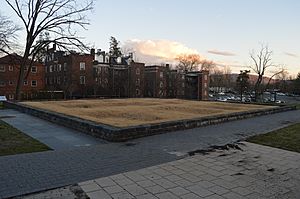Kitty Foster facts for kids
Catherine "Kitty" Foster (born around 1790, died 1863) was an African American woman who gained her freedom. She is famous for owning land near the University of Virginia from 1833 until she passed away. Today, her home is a special historical place on the university campus called the Foster Site.
Contents
Kitty Foster's Early Life
Kitty Foster was born enslaved in Albemarle County, Virginia, sometime between 1790 and 1795. The people who enslaved her were likely Henry Foster, a white farmer, and later his wife, Elizabeth Foster. We don't have many records about her parents or what her life was like while she was enslaved.
Gaining Freedom and Building a Home
Kitty Foster had three children: a daughter named Sarah (around 1816), and sons German Evans (1817) and Burwell Evans (1820). By 1820, Kitty was a free woman. She lived as a renter in a nearby African American community called Canada, Virginia. This community grew even though a law from 1806 said that newly freed African Americans had to leave Virginia within a year.
In 1830, the government census listed Kitty as white. This might mean she had a white father and a lighter skin tone. That same year, she had another daughter, Ann Foster. The father or fathers of her children are not known from historical records.
Buying Her Own Land
In December 1833, Kitty Foster bought a piece of land, just over 2 acres (about 0.81 hectares), from a white merchant named John Winn and his wife Mary. It was very rare for African American women to own property during this time.
Kitty lived on her new homestead for 30 years. She earned a living by working as a seamstress and washing clothes for students and teachers at the University of Virginia. University officials sometimes complained about free African Americans living so close to the campus.
Facing Challenges
In 1834, Kitty Foster's home was attacked by students. The university called their actions "disorderly." They threw flower pots and tried to break into her house. In 1837, the university accused her of keeping students' firearms, as students were not allowed to have guns on campus.
Her property was valued at $450 in 1850. By 1860, its value had increased a lot, reaching $4,000.
Kitty Foster's Legacy
Kitty Foster died in 1863. She was buried in what was probably a community graveyard on her own land. Her family continued to live on the property for three more generations, with women leading the household, until 1906.
The original house on the property was torn down in the early 1900s by new white owners. A new house was built there in the 1920s. This second house was later removed during construction in 2009. The new house had been built over the graveyard, even though the original deed for the land said the graves should be moved.
The University of Virginia bought the property in 1976. In 1993, archaeologists found the cemetery on what used to be Kitty Foster's land. Kitty and about three dozen other people were buried there. Since 2011, her homestead has been a memorial and historic site on the university campus, known as the Foster Site.


